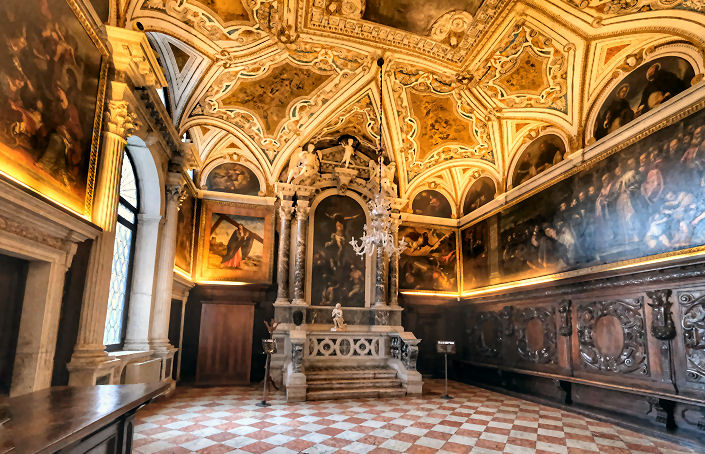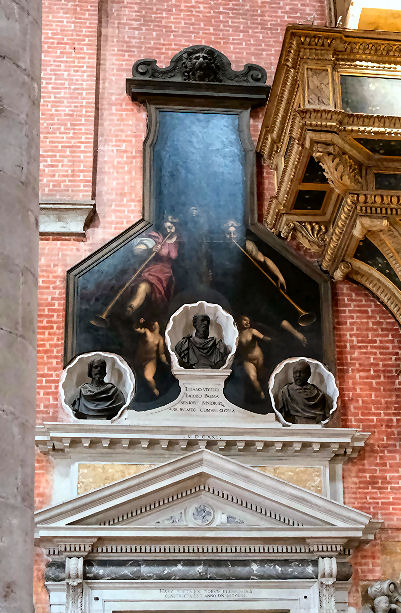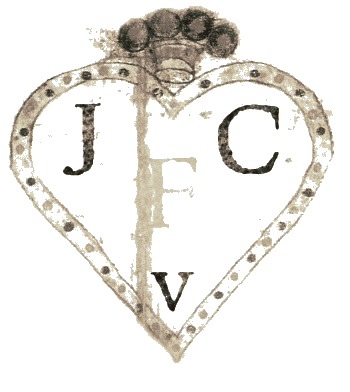
|
Santi Giovanni e Paolo |
||
|
History The largest church in Venice, this is the great Venetian church of the Dominican order, just as the Frari is for the Franciscans. The sites which were granted to them are far apart and both are far from the political centre of Venice. The land for this church was, like that for the Frari, presented by order of Doge Jacopo Tiepolo. This was in 1246, after he dreamt of a flock of white doves flying over it. The first church here was said to have been built in 983, but is first documented in 1184. The Dominicans' first church was completed during the 13th century. It was soon found to be too small, however, and work on a much larger church began in 1333. By 1368 the apses and transepts were finished but a shortage of funds halted work until the Maggior Consiglio (Grand Council) gave the Dominicans 10,000 ducats in 1390. By 1430 the nave was completed and the church was consecrated, with Bon's portal added in 1458-62, part of a planned marble fašade that never happened. Both Gentile and Giovanni Bellini were buried here, in February 1507 and November 1516. Like the Frari San Zanipolo also gets called 'a Venetian Pantheon' as it has twenty-five tombs of doges. The church was not, as you might think, named after the apostles John and Paul but two obscure soldier-martyr saints of the same names. Images of these saints can be seen in the stained glass window, standing alongside Saints George and Theodore, two of Venice's three patron saints. The church The west frontĺs huge unfinished fašade contrasts with the marble-clad elegance of the decorated fašade of the adjoining Scuola Grande di San Marco. The portal is by Bartolomeo Bon, begun in 1459, with columns salvaged from a church on Torcello. It therefore mixes classical details into its essentially gothic form, said to have been the style's last gasp in Venice. It looks like the columns were meant to continue along the fašade. It's thought that the Dominicans ran out of spolia. They tried to get some columns from the demolition of San Severo in Ravenna, but the pope refused their request after an outcry by the citizens of Ravenna. The fašade has the tombs of three doges including, second on the left, Jacopo Tiepolo, who gave the swampland on which the church was built. After the carving of the cornice in 1463 work on the fašade was abandoned. Notice too the lack of a campanile. Interior The interior looms impressively, cross-vaulted, with 10 stout plain columns of Istrian stone blocks and wooden tie beams. These are all features it shares with the Frari, but San Zanipolo lost its wooden choir in 1682 and so seems larger and airier. The well-lit choir draws the eyes with all its Gothic windows and its Baroque high altar of 1619, attributed to Longhena. The stained glass windows at the end of the right transept are rare surviving examples from the period, produced on Murano in 1473 to designs mostly by Bartolomeo Vivarini.  Art highlights Art highlightsLess chock-full of crowd-pleasing paintings than the Frari, San Zanipolo does have the Giovanni Bellini Vincent Ferrer polyptych (see right) which is in its original frame. Itĺs an early work - his first important independent commission - but is somewhat lacking in the polished serenity and originality of his later work, and with considerable studio involvement, especially in the predella. The polyptych was painted around 1465-8, when the influence of the sculptural style of Mantegna, his brother-in-law, was still strong on Giovanni. It was commissioned by the scuola piccolo devoted to the then-new saint, who had a reputation as a miraculous healer, which may have increased his popularity in Venice after the plague outbreak of 1464. There's also the odd 1542 Alms of Saint Antoninus of Florence by Lorenzo Lotto (see below right) in the right transept. It's notable for depicting a somewhat hierarchical model of charity, with the saint himself having no direct contact with any poor person. Antonio Pieruzzi had been a leading Observant reformer of the Dominican Order, only just canonised, in 1523. He it was who had founded the SocietÓ dei Buonuomini that met in San Martino in Florence and he had been the prior of San Marco before becoming Archbishop of Florence. Amongst the throng of supplicants at the base of the painting, all looking like portraits, the central bearded figure in an orange robe has been recently convincingly argued to be a portrait of the artist. The carpet draped over the parapet behind his head is one of many designs of Anatolian carpet that have become so well known from their use by Italian artists that they have become named after them, even in Turkish museums, so this one is now known as the Lotto carpet. Lotto worked often for Dominicans, but they paid him little for this - his fee of 125 ducats had 35 deducted in exchange for a 'free' funeral, which never happened as Lotto died in the Marche. This Capella del Rosario was built in 1582, to designs by Alessandro Vittoria, to commemorate the victory at Lepanto, a battle fought on the feast of the Madonna of the Rosary, the 7th of October. The paintings in here by Veronese came from the demolished churches of San Nicol˛ della Lattuga and Santa Maria dell'UmiltÓ and replaced the original paintings by Tintoretto on the ceiling of the Capella del Rosario here which were destroyed by the fire of August 1867 (see below). These include The Assumption, The Annunciation, The Adoration of the Magi and four surrounding L-shaped Evangelists. Also The Adoration of the Shepherds on the wall. The paintings from Santa Maria dell'UmiltÓ were brought here later, having been taken to Vienna in 1821, following the demolition of the church, and only returned to Venice at the end of World War I, being installed here in June 1925. At the end of the north aisle are three panels from a 10-panel polyptych by Bartolomeo Vivarini painted for the first altar on the left of the church, dedicated to St Augustine, founded by patrician Marco Dolfin. The panels depict Saints Dominic, Augustine and Lawrence. The altarpiece was still intact in 1815 but had been broken up by 1822. Two other panels which may have survived cut down are the Virgin and Child in the Correr Museum, and the Saint Mark could be in Berlin or New York.  The 16th-century sacristy has a Christ carrying the Cross by Alvise Vivarini, to the left of the altar (see photo above). In here is also one of a pair of marble kneeling angels by Giovanni Battista Bregno made for the church of Santa Maria dei Servi, the other is in the Staatliche Museen in Berlin.  Over the entrance to the sacristy is the oddly-shaped 1628 tomb of the ubiquitous Palma Giovane (see right), designed by himself, with a painted Allegory of Fame and busts of himself, Palma Vecchio, his famous and talented great uncle, and Titian. There is an argument that this carved company does not constitute an act of vanity as he places the others above himself. The Chapel of Saint Dominic. off the right aisle, has a ceiling painting of The Glory of Saint Dominic by Piazzetta from 1726, along with four small ovals depicting virtues. It is the artist's only known ceiling painting and the biggest church commission of his career. The tombs of doges are a bigger draw - there are twenty-five here - after the 15th century all of their funerals were held here. Especially fine are the three for the Mocinego doges on the entrance wall (see right). The one on the left (as you face the back wall) to Doge Pietro is by Pietro Lombardo, with the help of his sons Tullio and Antonio. It glorifies the war-like Doge's military achievements, with classically-inspired pagan imagery, like scenes featuring Samson, and with Christian themes only getting a look in towards the top with the relief of The Three Marys at the Sepulchre. The tomb on the right to Doge Giovanni is by Tullio Lombardo, the elder son, probably with the help of his brother Antonio. The tomb in the middle, of Doge Alvise I and his wife Loredana Marcello, is later and probably Palladio-designed. It is embellished with two saints taken from Doge Pietro's tomb and incorporates the memorial to Bartolomeo Bragadin, which did not make the Bragadin family happy. Marcantonio Bragadin's tomb, by Scamozzi is also here. He being the Captain of Venetian forces at Famagusta when it was taken by the Turks, who was tortured and flayed alive and his stuffed body paraded around the town seated on a cow. His remains were stolen from the arsenal in Constantinople nine years later, returned to his family and interred here. The tomb of Doge Giovanni Dolfin is still flanked by fragments of monochrome frescoes of Virtues by Guariento, the Paduan painter, which where damaged by the moving here of Doge Andrea Vendramin's tomb from Santa Maria dei Servi.
Lost art -
the 1867 fire
Opening times
|
San Zanipolo in a photochrom print of c.1890. |
|
|
|

Home
Cannaregio ::
Castello :: Dorsoduro ::
Giudecca :: San Marco ::
San Polo :: Santa Croce
:: The Islands :: Demolished